This incredibly simple recipe for a rosemary and ginger infused oil is a fantastic topical home remedy for muscle aches, inflamed joints, sciatica/neuralgia, poor circulation, and cold hands and feet.
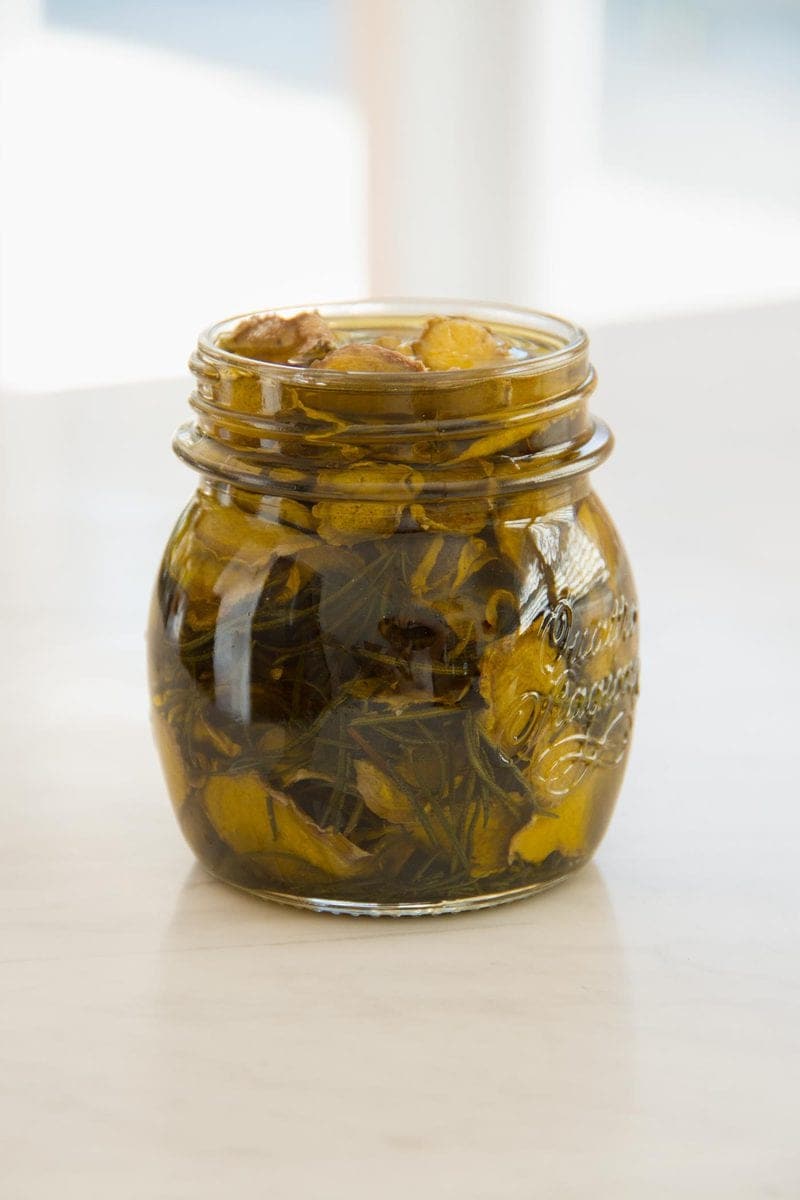
Some of our most common culinary herbs are often the most overlooked therapeutically – rosemary and ginger are two perfect examples.
This recipe is for a herbal-infused oil, to warm, soothe and boost blood flow – perfect during the change of seasons, using simple ingredients you’re likely to already have on hand at home.
[bctt tweet="Homemade rosemary + ginger oil – a natural remedy for poor circulation, muscle aches and pain. Recipe here!" username="laurenglucina"]
Use this infused oil as a topical rub to…
- Penetrate the skin and stimulate circulation, driving blood flow to the extremities, warming up cold hands and feet
- Massage over calves, thighs, neck, back and shoulders – anywhere you’re experiencing tension or muscle pain due to exercise
- Massage into inflamed joints to act as a mild analgesic, providing relief from rheumatic pain
- Help relieve nerve pain – massage over the hips, buttocks and thighs for sciatica
You’ll need:
- Fresh rosemary
- Fresh ginger root
- Olive, almond, fractionated coconut or raw, untoasted sesame oil (whichever you prefer or have on hand)
- Sterilised glass jar with a tight fitting lid
- A double boiler, if using the stovetop method of infusion
- Optional: ginger and rosemary essential oils for an extra therapeutic boost
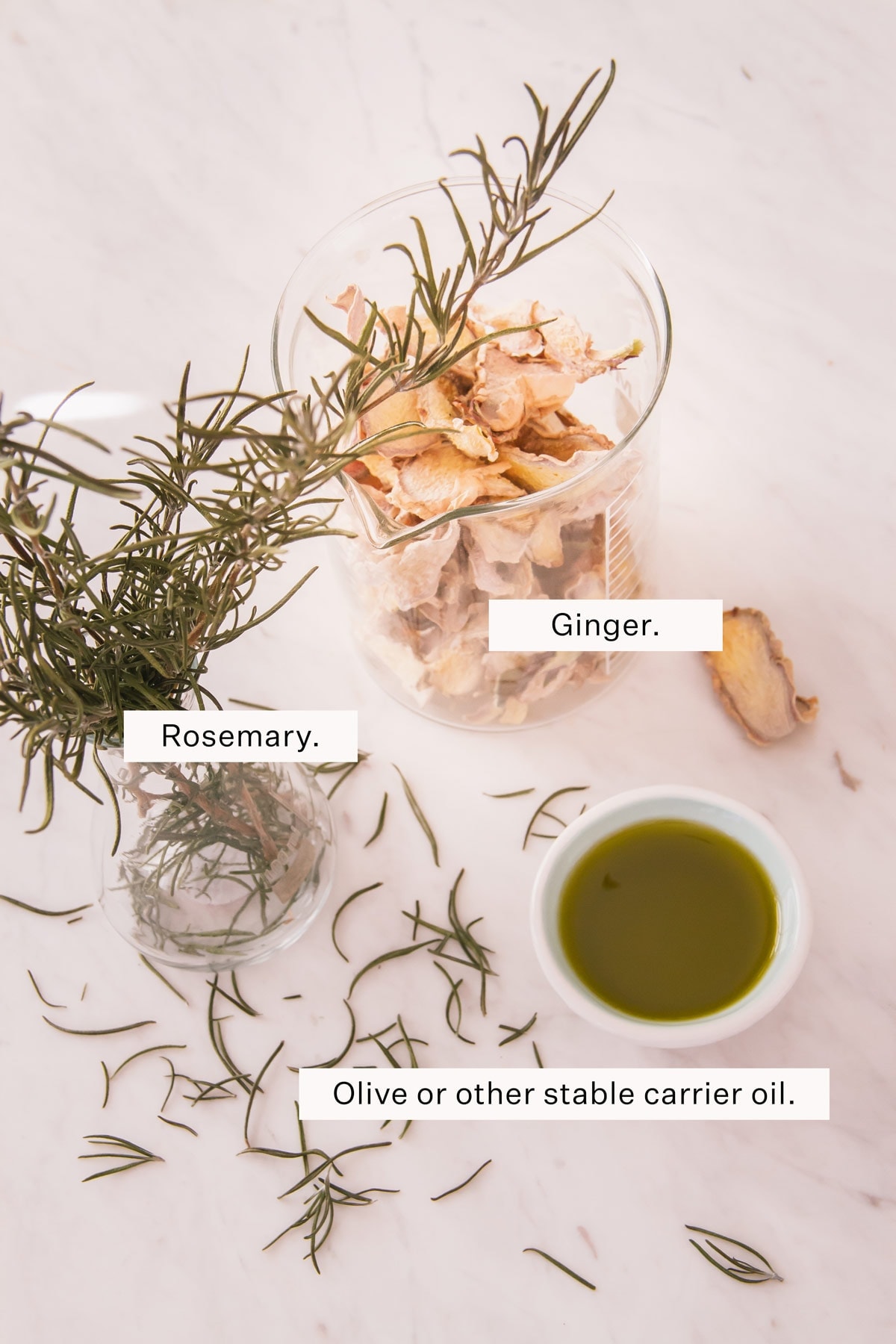
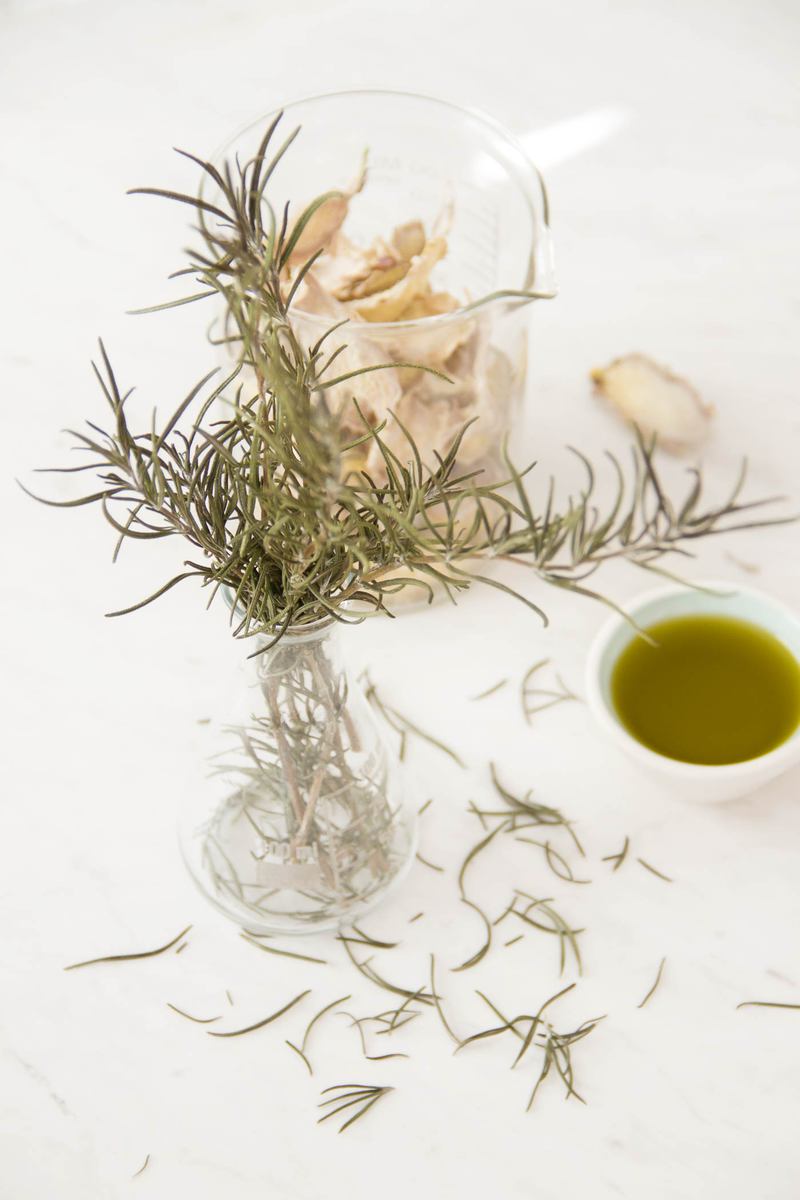
How to make an infused oil: Sun infused vs the stovetop method
There are two ways to approach making a herbal infused oil – the sun or stovetop method.
The sun method involves packing your freshly dried herbs in a jar, covering with an oil of your choice, then capping and placing in sunny area such as a windowsill and allowing to infuse over the course of several weeks, giving it a good shake each day.
Once infused – you can either strain the herbs out , compost them and keep the infused oil, or leave them in and use as is.
Your herbs have to be dry to use this method because the water content of fresh herbs can spoil the oil.
The pro’s of this method are that it really takes no time at all to prepare – you just need to plan your medicine making in advance to allow enough time to infuse. The con’s, for this particular recipe (being high in volatile oils), is that by nature dried herbs contain less volatiles than fresh, so it is perhaps not as potent as it could be if using the stovetop method.
How to dry fresh herbs
When drying rosemary and other fresh herbs, tie a bundle with string and hang upside down in a warm, dry room – leave them to air dry then store in a dark airtight container out of direct light – a glass amber jar is ideal.
Alternatively, if you have a dehydrator, you can arrange the herbs over a tray dehydrate over the course of 24 hours or more. Herbs rich in volatile oils, like rosemary and ginger, shouldn’t be exposed to temperatures greater than 40˚C / 104˚F, to prevent them from evaporating.
Once your herbs have dried, it’s ideal to use them in medicine making as soon as you’re able – they will naturally degrade over time.
In the case of roots and rhizomes like ginger, it’s best to slice them thin and dehydrate.

The Stovetop method
The Stovetop method of infusing herbs takes longer to prepare initially, but then does away with the several weeks needed to infuse.
Simply add your herbs (fresh or dried) to a double boiler, cover entirely with a stable carrier oil, then heat at a low temperature for 2-8 hours (the longer the time, the greater the extraction of constituents) and until the oil starts to take on the colour of the herbs. The water shouldn’t be brought to a boil, and shouldn’t reach over about 40˚C / 100˚F.
You can place a lid over the double boiler to prevent the essential oils from evaporating, and if using fresh herbs, ensure they are thoroughly dry.
Once the infusion process is complete, you strain and jar as above.
You’ll see in the photos here I’ve gone with dried herbs, using the sun method, and added essential oils to further enhance the potency.
Selecting your carrier oil
Choose a quality shelf stable oil – my suggestions are extra virgin olive oil, almond oil, fractionated coconut oil or raw, untoasted sesame seed oil.
Olive oil is widely used in herbal medicine making because it is readily available and affordable – great for use in balms and salves.
Almond is a great option but will have a slight marzipan scent, fractionated coconut oil is wonderful as it is lightweight and scent free, and raw sesame oil is the oil of choice in Ayurvedic practices.
Do you need to add essential oils?
No – however, this particular preparation is quite mild (though ideal for frequent, everyday use).
If you need something a little stronger, this is where the essential oils come in, but they have to be diluted appropriately – a 1-3% dilution is a good place to start.
If you’re using essential oils, you can add these after the oil has infused – just decant a tablespoon of oil into a small dish, then go from there.
Using your herbal infused oil
Once your oil is made – be sure to label and date it, then simply apply topically as needed.
The medicinal properties of rosemary
Rosemary has long been considered the herb for circulation and memory enhancement. It is often referred to as the ‘herb of remembrance’ and a sprig of it on your desk is said to help improve your memory as you study.
The essential oils also act as a pick-me-up, stimulating the central nervous system. A mix of lavender together with rosemary is also said to lift the spirits.
Today, Rosemary is used as a nervine, nootropic, circulatory stimulant, carminative, antioxidant, hepatoprotective and antimicrobial.
This is a warming herb, stimulating circulation and blood flow, which is why it is so effective for the brain, increasing mental alertness, cognition and memory.
Similarly, effective for headaches and digestive tension, and an excellent musculoskeletal remedy. When massaged into the skin over muscles and joints, it helps enhance circulation, driving blood flow right to the capillaries.
As a member of the mint family (like peppermint and lemon balm), it has carminative properties – meaning it helps relieve intestinal gas, spasm and pain.
Rosemary also has a high antioxidant content and protects the liver, supporting detoxification pathways.
In Western Herbal Medicine, we most often use rosemary as a high ethanolic tincture, to extract the widest arrange of therapeutic constituents.
The medicinal properties of ginger
Also considered a warming circulatory stimulant, ginger is one of my favourites as it is so readily available, smells and tastes divine, and has so many therapeutic benefits.
Aside from promoting blood flow, ginger is highly anti-inflammatory, with clinical trials to support its use in reducing arthritic and other inflammatory pains. Ginger also has analgesic (pain relieving) effects, a useful ally for women with painful menstruation and cramping, similarly – very effective for headaches and migraine.
Digestive complaints are also wonderfully supported by ginger – it helps promote gastric emptying and gut motility, is protective against ulcers, stimulates gastric secretions, eases gas, calms the gut, reduces nausea and relaxes tensions and spasm.
Rosemary and ginger combined are the perfect duo to as an antidote to any cold conditions. Both can be used for congestive chest problems.
Its diffusive actions make it super helpful in a herbal formula to help open up the circulatory pathways and drive the remedy out to peripheral tissues.
Two wonderful herbs we should always have on hand!
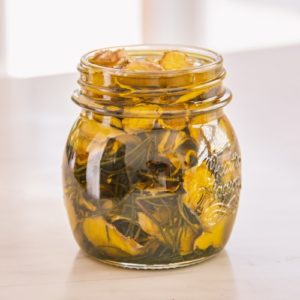
Rosemary and Ginger Infused Oil
Equipment
- 250ml glass jar with tight fitting lid
- Dehydrator (optional, can air dry herbs)
Ingredients
- 1 fresh ginger root
- 1 bundle rosemary sprigs
- 250 ml carrier oil of your choice extra virgin olive oil, almond, fractionated coconut oil, raw sesame oil
- essential oils of your choice optional, see notes
Instructions
- Slice ginger into really thin pieces, arrange on a dehydrator tray with rosemary sprigs, and dehydrate at a maximum temperature of 40˚C / 104˚F, until dry (exact time will vary depending on the season, 24 hours is a good starting point).
- Fill a glass jar with dried plant material, then pour the oil over the top, right to the very top so there is no space for any air to get in.
- Gently tap the jar on a hard surface to remove any bubbles, then cap the lid. Let it infuse like this for 2-3 weeks on a sunny windowsill.
- After this time, strain the oil into a new jar – preferably dark coloured (amber or blue),and store in a dark, cool place.
- To use, massage into your hands and feet to boost circulation and ease pain/inflammation as needed. You can decant a tablespoon of oil into a small dish and add essential oil if you’d like to incorporate them, I suggest 4 drops per 15ml application.
Notes
- It is important to have dry plant material when making infused oils so that they don’t ferment.
- Essential oils to complement the herbs include rosemary, ginger, black pepper, frankincense, lavender.



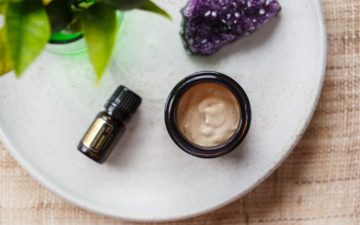
Ascension Kitchen
Hi Erin 🙂 I would put it on a low setting and keep an eye on it, just till it is dry and there's no moisture... the rosemary may be ready quicker than the ginger...
Trudy Parry
You've reawakened the herbalist in me - and thank you for the lovely reminder about setting intentions.
Erin Smallbon
How beautiful Lauren!! I am going to try this! For those who don't have a dehydrater, how long would you leave the ginger and rosemary in the oven for? And at what temperature?
Loving your work!!!
xxx